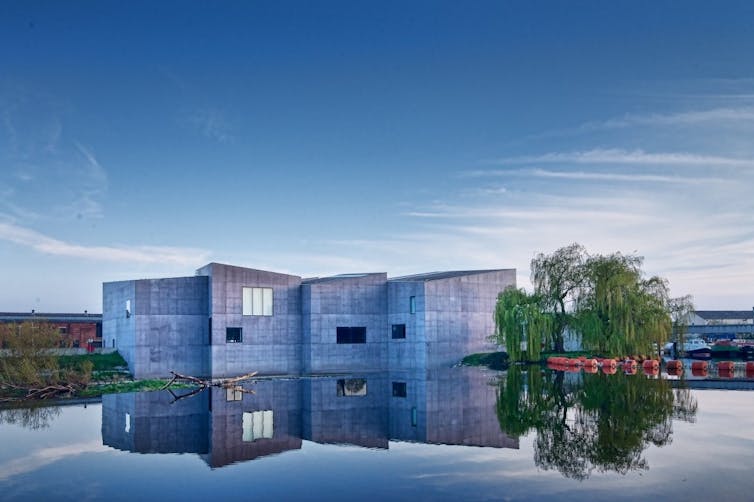The British architect David Chipperfield has been announced as the winner of the 2023 Pritzker Architecture Prize, arguably the highest international honour in the discipline. In its citation, the jury highlighted the elegance, restraint and permanence that have consistently characterised Chipperfield’s oeuvre, “an architecture of understated but transformative civic presence”.
Born in London in 1953, Chipperfield graduated from the Architectural Association School of Architecture in London in 1980, after undergraduate studies at the Kingston School of Art. He started out working for seminal British architects Douglas Stephen, Norman Foster and Richard Rogers, before founding his own firm in London in 1985. With additional offices now in Berlin, Shanghai, Milan and Santiago de Compostela, his output has spanned civic, cultural, academic and residential buildings, as well as urban planning throughout Asia, Europe and North America.
Chipperfield’s driving ethos, as the Pritzker jury members emphasised, has always been to choose the tools needed for the project at hand. As opposed to the “starchitect” impulse to create something iconic and instantly recognisable – to stamp their mark on a place – architecture, for him, is a vehicle to pursue civic and public good, even if that means “almost disappearing” behind it. Here are five projects that embody that classic imperative: to achieve something that will stand the test of time in serving the people who need it.
1. Museum Folkwang, Essen, Germany, 2007-2009
Housing one of the first collections of modern art in Germany, founded in 1902, this museum organised a competition to extend its 1960s premises in 2007. Museums have been a consistent focus for Chipperfield. Here, he recognised the importance of working with, but not overwhelming, the museum’s history. He added six simple structures, clad in slabs of glass, and four inner courtyards, an ensemble that flows so seamlessly from the original building, it becomes almost invisible.
The jury citation put it plainly:
We do not see an instantly recognisable David Chipperfield building in different cities, but different David Chipperfield buildings designed specifically for each circumstance.
2. The Neues Museum Berlin, Germany, 1993-2009
Here Chipperfield reinstated the original use of the Neues Museum Berlin, “a masterpiece of Prussian classicism”, according to German construction historian Werner Lorenz, that was partially destroyed in the second world war. His minimalist intervention included an archaeological restoration of the original building, which had been left exposed to the elements for decades, and new volumes added in pale cement and recycled brick. The result is a history lesson, the different layers of the building made visible, from 19th-century colonnades to 1940s bullet holes and scorch marks.
It is modern without being overpowering and it showcases Chipperfield’s concept of permanence. As he put it in 2013: “In this age of throwaway and the redundancy of everyday things, taking care of, valuing, and treasuring seem old-fashioned concepts.” Permanence, for him, is “a declaration of lasting priorities. The organisation of buildings and their integration in a larger whole give shape and solidity to our vague ideas of society”.

3. Inagawa cemetery chapel and visitor centre, Inagawa, Japan, 2013-1017
“Good architecture provides a setting,” Chipperfield has said. “It’s there and it’s not there. [It] is something which can intensify and support and help our rituals and our lives.”
In Inagawa he demonstrated the importance of learning from the past – of understanding the essence of rituals and making them relevant to contemporary contexts. Located on a steep hillside in the Hyogo prefecture, north of Osaka, he created a pink-hued concrete structure around a courtyard, with a monumental staircase leading up the hill to the shrine.
The building connects directly with the topography of the landscape. The materials used are subtle and the design is minimal. As a whole, it promotes reflection and contemplation. It is architecture that is almost not there, precisely attuned to its function.
4. The Hepworth Wakefield, West Yorkshire, UK, 2003-2011
This purpose-built gallery, located on the river Calder within the Wakefield waterfront conservation area, embodies Chipperfield’s approach to sustainability, which the Pritzker jury citation defines as striving for “pertinence”. Chipperfield eliminates the superfluous, and creates “structures able to last, physically and culturally”.
Skylights and floor-to-ceiling picture windows allow visitors to engage with the post-industrial riverside setting from subtle, luminious interiors. The pigmented concrete of the structures was mixed on the site, giving the whole a sculptural feel, in celebration of Barbara Hepworth, the Wakefield-born artist and museum’s namesake. The building uses the river for its heating and cooling system.

5. Fundacion Ria, Galicia, Spain, 2017
In recent years, Chipperfield has extended his work to support further engagement with local communities, learning about their needs and their contexts, moving away from global solutions. In 2017, he founded Fundacion Ria, a private, non-profit that sponsors research and future development in Galicia, northwestern Spain, one of the poorest regions in the country.
The foundation’s exploratory projects encompass planning (integrating the seafront into the urban fabric of the region’s small seaside towns) and sustainable land management (setting up an “ecosocial laboratory” to study how local farmland has been managed, historically). As the foundation’s website puts it:
Essentially, what we have to hope now is that the environmental crisis makes us reconsider priorities of society, that profit is not the only thing that should be motivating our decisions.
Ana Souto ne travaille pas, ne conseille pas, ne possède pas de parts, ne reçoit pas de fonds d'une organisation qui pourrait tirer profit de cet article, et n'a déclaré aucune autre affiliation que son organisme de recherche.
This article was originally published on The Conversation. Read the original article.







